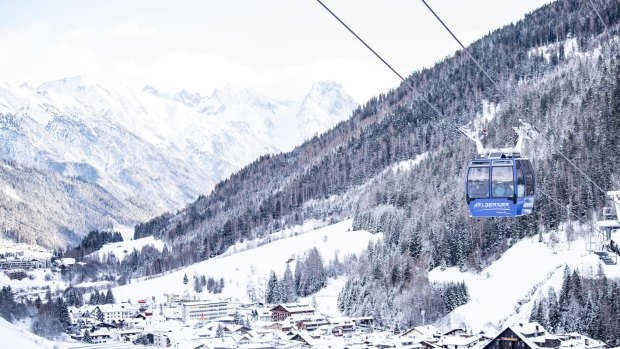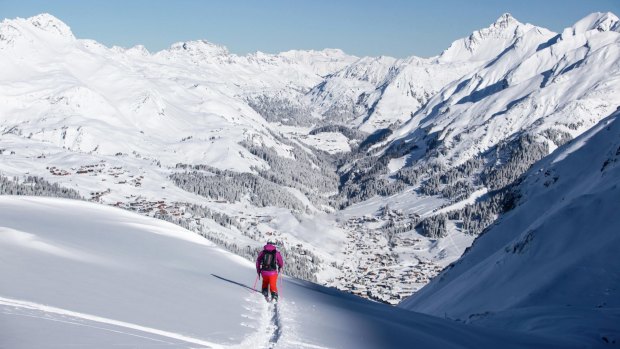This was published 1 year ago
Arlberg, Austria: A novice in the land of the world's best skiers

Arlberg is the cradle of alpine skiing.
You must treat the snow like your dance partner, says ski instructor Nils Otto as we float in a gondola high above the Arlberg. The allegory is especially apt from this perspective: far below us, skis carve movement and rhythm into the enamel-bright snow as their wearers shimmy and sway towards the valley floor. These performers are the dance troupe, and we their box seat audience.
"The snow isn't your enemy," Otto reaffirms. "You need to make friends with it."
My relationship with the snow is fraught; a novice skier, I fool no-one with my quivering gait and fear-contorted expression. Compounding my unease is the Arlberg's reputation: this region is the cradle of alpine skiing, and it has forged the careers of some of the world's most accomplished skiers. It is threaded today with the laser-sharp tracks of people who clearly know what they're doing. If you learn to ski in the Arlberg you'll be able to ski anywhere in the world, says the legend. If only I had known.

Mountains bulwark the valleys and serrate the skyline overhead.
But these somewhat intimidating credentials don't preclude beginners and intermediate skiers; they're matched, moreover, by attributes I'm easily able to appreciate: singular landscapes, enchanted settlements, captivating histories. Nestled in the valley below are the hamlets of St Anton and St Christoph, and beyond them the three other villages anchoring the Arlberg: Stuben, Zurs and Lech. Mountains bulwark the valleys and serrate the skyline overhead. Slopes and fields, canopies and rooftops slump beneath enormous pillows of snow. The sky is radiantly blue.
"You just have to enjoy every sunbeam, because tomorrow the weather might change," Otto says.
"Lean into your fear. Let's make friends with speed!"
Sunshine and speed alchemise into a hallucinatory drug as I launch myself from the top of a run into what feels like endless freefall. Spangled ice sprays my cheeks, gravity wrenches my nerves, wind roars by like a freight train. I skid to a breathless, clumsy halt at the bottom of the run and wait for my defibrillated heart to quieten. That night, on my way to Museum Restaurant and Cafe – a gingerbread manse tucked into a grove of trees at the base of a run – I see night skiers rippling like pebbles down ghostly slopes. They're returning from après ski, says a woman at the restaurant. They ski down tipsy and lose things; then, when the snow melts in the spring, all sorts of lost property emerges from the thaw.
"Beanies, wallets, gloves, phones," the woman says.
The Tyrolean-style hunting lodge in which the restaurant is housed conceals its own surprises: it was built by German industrialist Bernhard Trier in 1912 after the railway was laid through the valley in the late 19th century, bringing settlers along with it. Influential people would gather here – including alpine ski pioneer Hannes Schneider, who was born in nearby Stuben. During WWII the house became a refuge for injured soldiers and, during the occupation, home to the French governor. Today it has reclaimed its Austrian heritage: its antique-filled rooms are set for dinner and weary skiers are refuelling with immense Wiener schnitzels, dumplings swimming in oxtail consommé and kaiserschmarren – a shredded pancake-and-fruit pudding named for Emperor Franz Joseph I. Outside stands a towering pine tree; its outstretched limbs glitter with Christmas baubles, guiding the après skiers home.
Overnight, a blizzard blots the sky and shutters St Christoph's ski lifts. I clip snowshoes to my boots and cut a ponderous trail through the drifts; the gondolas sway idle and empty above me. It's a short drive to Stuben along the Arlberg Pass, which cuts from Tyrol into Vorarlberg and zigzags through precipitous mountains into the valley. But the journey wasn't always so effortless: travellers crossing the Arlberg would take respite in huts built in Stuben for this purpose.
And the village is indeed a sight for weary eyes, though it lies deathly still beneath last night's snowfall. The walls of the ivory-painted church, Filialkirche Stuben, appear to have been erased altogether: only its dome and gothic windows are traced in black against the spectre; its gold cross is lacklustre in the gloom. But warmth is restored at Hotel Mondschein, where local specialities – schmalz, sausages, schnapps – are being served in a restaurant lined with photos of the village's world-famous son, Hannes Schneider.
"Around 1900, he noticed ski was up and coming," says Gebhard Pichler, Stuben's tourism director. "He built his own skis from a wooden barrel. People laughed at him – his father wouldn't let him get skis."
Schneider's father, a farmer, had expected his son to become a cheesemaker. Instead, he went on to develop the world-famous Arlberg technique, which helps such novices as me progress from simple snowploughs to complex parallel turns. Schneider made a hard turn himself when the Nazis annexed Austria; he fled to New Hampshire, spreading the cherished reputation of his home village as he went.
Innate caution has hampered my own mastery of Schneider's technique, but I marvel at it from the gondola high above Zurs. The world below is a tumbling ocean of white, sullied only by the protruding roofs of entombed huts; skiers skim the bright surface, leaving precision strokes in their wake. I discover a counterpoint to this monochrome vista down in the village at Filialkirche Christkönig; stepping over snow drifts into the nave, I'm enfolded in colour: the emerging sun has cast Martin Häusle's fabled stained glass windows upon the walls in oblongs of indigo, pink and violet.
Nearby, at Lech's old Kirche St Nikolaus, the long-dead are now drowned by snow; only the tips of their gravestones have been spared by the avalanche. But colour is the saviour again tonight at Kristiania Lech, where Gertrud Schneider curates art, history, books, conversation, cocktails and cuisine into a singular experience (the space now operates as a pop-up only during the summer months). The lodge was originally built by her father, Austria's first male Olympic ski champion Othmar Schneider, as a bolthole for friends.
"For us it was a castle," Schneider recalls of her childhood. "We had to dress nicely and behave."
It's a tradition that endures: Schneider is an elegant host, offering flutes of champagne, recommending specialties, telling compelling stories of the Arlberg and the contemporary artists who exhibit in her gallery. The dining room is warmed by jewel colours; through the window, we can see lights speckling the dark: snow groomers gliding down the Lecher mountainside.
"It's a ballet of the snow cats," Schneider says.
And from our sumptuous box-seat we watch the evening performance on that immense, snow-lit stage.
Catherine Marshall was a guest of the Austrian National Tourist Office.
THE DETAILS
FLY
Qatar flies daily from Sydney and Melbourne to Doha, with regular onward flights to Zurich. See qatar.com. St Anton is around three hours by train or car from Zurich. See raileurope.com. Buses and taxis operate between the Arlberg's five ski villages. See stantonamarlberg.com/en/service/timetables.
STAY
Rooms at The Arlberghaus in Zurs start from $228. See arlberghaus.com/en-EN. Rooms at Hotel Mondschein in Stuben start from $176. See mondschein.com/en. St Anton's Arlberg Hospiz Hotel is undergoing refurbishment and will be open for the 2022/2023 winter season. See arlberghospiz.at/en.
VISIT
Visitors can hire ski equipment and book ski, snowboard and cross-country skiing lessons in the Arlberg's resorts. See stantonamarlberg.com; stantonamarlberg.com/st-christoph; lechzuers.com and stuben-arlberg.at. Kristiania Lech is open on weekends during summer. See www.kristiania.at. St Anton's Ladies First event takes place from 7 to 28 January 2023. See stantonamarlberg.com/en/events.
MORE
Sign up for the Traveller Deals newsletter
Get exclusive travel deals delivered straight to your inbox. Sign up now.